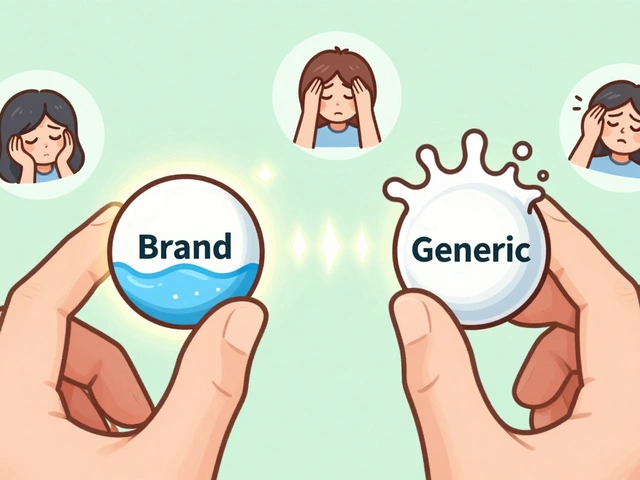When your vision suddenly flickers like a broken lightbulb, or you see zigzag lines that seem to crawl across your field of sight, it’s natural to panic. Is this a stroke? A brain tumor? Or just a weird migraine? Many people call it an ocular migraine, but that term is misleading-and it could cost you time, peace of mind, or even your vision if you don’t understand the real difference.
Two Very Different Conditions, One Confusing Name
The phrase "ocular migraine" is used by patients and even some doctors to describe any visual disturbance linked to migraine. But medically, there are two completely different things happening:- Migraine with visual aura affects both eyes. You see shimmering lights, blind spots, or jagged lines that start in the corner of your vision and spread. Even if you close your eyes, you still see it. This is the most common type-about 1 in 4 people with migraines experience it.
- Retinal migraine affects only one eye. Your vision in that eye goes dim, gray, or completely black for a few minutes. It’s rare-less than 1% of all migraine cases-and it’s caused by changes in blood flow to the retina, not the brain.
The confusion matters because the risks and treatments are totally different. If you think you have a "migraine in your eye" and ignore it, you might miss something far more serious.
What the Visual Aura Actually Looks Like
If you’ve had migraine with aura, you probably remember it vividly. It doesn’t feel like a glitch-it feels like your brain is projecting something onto your vision. Common symptoms include:- Scintillating scotomas: A flickering blind spot, often shaped like a crescent or crescent moon, that grows over 20-30 minutes.
- Zigzag lines: Sometimes called "fortification spectra," these look like the walls of a medieval castle.
- Flashing lights or stars: Like someone turned on a strobe light behind your eyes.
These symptoms usually start in the outer edges of your vision and slowly move toward the center. They last between 5 and 60 minutes, with most people experiencing them for about 27 minutes. You might also feel tingling in your hand or face, or have trouble finding the right words. Headache often follows, but not always.
Retinal migraine looks different. It’s not a pattern-it’s a loss. You might notice:
- One eye going gray or blurry, like a fog rolling in.
- Complete, temporary blindness in one eye.
- A shimmering or flickering effect that stays in the same spot.
Unlike migraine with aura, closing your eyes won’t make retinal symptoms disappear. They’re tied to the eye itself. And they’re short-usually under 20 minutes, often just 10-14 minutes.
Why the Difference Matters: Brain vs. Eye
Migraine with aura comes from your brain. It’s caused by something called cortical spreading depression-a slow wave of electrical silence that moves across the visual cortex. Think of it like a blackout that spreads across a city grid. Your brain’s visual processing centers temporarily shut down, and what you see is the result.Retinal migraine is different. It’s likely caused by a temporary narrowing of blood vessels supplying the retina-the light-sensitive layer at the back of your eye. Less blood flow means less vision. It’s similar to a mini-stroke in the eye, but it reverses quickly.
This distinction is critical. Migraine with aura is uncomfortable but not dangerous in itself. Retinal migraine, however, can be a warning sign of vascular problems elsewhere in your body.

When to Worry: The Six Red Flags
Most visual auras are harmless. But some symptoms are not normal-and they need immediate attention. Here are the six red flags from the American Academy of Neurology’s 2023 emergency guidelines:- Lasting longer than 60 minutes. Most aura symptoms fade within an hour. If yours last longer, it could be a stroke or TIA.
- First-time aura after age 50. New visual disturbances after 50 are not typical migraines. They could signal a tumor, stroke, or giant cell arteritis.
- Weakness on one side of your body. If your arm or leg feels numb or heavy along with the vision changes, this is a major red flag.
- Symptoms that don’t follow the usual pattern. If your aura starts in the center of your vision, or moves backward, or looks totally different from past episodes, it’s not typical.
- No headache after the vision loss. Especially if you’re over 50. Migraine with aura usually leads to headache. If it doesn’t, and your vision is gone, it could be a retinal artery occlusion.
- Repeating episodes in the exact same spot. Migraine aura moves and changes. If you get the same blind spot every time, it could be a sign of a blocked blood vessel.
One of the most dangerous mimics is giant cell arteritis-an inflammation of blood vessels in the head, especially common in people over 50. It can cause sudden vision loss in one eye, scalp tenderness, jaw pain when chewing, and weight loss. If untreated, it can cause permanent blindness in weeks. Blood tests (ESR and CRP) can catch it early.
Another mimic is amaurosis fugax-a temporary vision loss caused by cholesterol plaques blocking the carotid artery. It feels just like retinal migraine but can lead to stroke. If you’re having multiple episodes in a day, especially if you’re over 50 or have high blood pressure, you need a carotid ultrasound.
What You Can Do: Prevention and Treatment
If you’ve been diagnosed with migraine with aura, you’re not stuck with it. There are proven ways to reduce how often it happens:- Triptans (like sumatriptan nasal spray) can stop an attack if taken early-about 72% of people get relief within two hours.
- Gepants (like rimegepant) are newer options that don’t constrict blood vessels, making them safer for people with heart risks.
- Preventive meds like propranolol (a beta-blocker) or erenumab (a CGRP antibody) can cut aura frequency by more than half.
- Magnesium supplements (600mg daily) reduced aura frequency by over 40% in one major study.
- Stress management and regular sleep cut aura episodes by 30-37%.
But if you have true retinal migraine, things change. Triptans and other vasoconstrictors are not recommended-they could worsen the blood flow problem in your eye. Your doctor will likely focus on managing underlying vascular risks: high blood pressure, cholesterol, smoking, or diabetes.

Real Stories, Real Delays
Many people wait years to get the right diagnosis. On Reddit’s migraine community, 68% of respondents said they were initially told it was "just stress" or "nothing serious." One person waited eight months before finding out they had 70% blockage in their carotid artery. Another spent years being told their vision loss was "psychological"-until a neuro-ophthalmologist did a visual field test during an episode and confirmed retinal migraine.Validation matters. Knowing it’s real-and knowing it’s not a stroke-can change your life.
What’s Next: New Research and Hope
Scientists are making progress. A new drug called tonabersat, which targets the brain’s electrical wave (cortical spreading depression), reduced aura duration by nearly half in early trials. Blood tests for CGRP levels are becoming more accurate at predicting aura onset. Advanced retinal imaging is helping doctors tell the difference between retinal migraine and carotid disease-something that used to require guesswork.Long-term, the outlook is good. Most people with migraine with aura never lose vision. Even those with retinal migraine, if properly monitored, rarely develop permanent damage. But only if they get the right diagnosis early.
Can ocular migraines cause permanent vision loss?
True retinal migraine rarely causes permanent vision loss-but it can be a warning sign of a serious condition like carotid artery disease or giant cell arteritis, which can. Migraine with aura does not cause permanent vision damage. If you experience vision loss that lasts longer than an hour, or if it happens repeatedly in the same spot, see a doctor immediately.
Should I get an MRI if I have visual aura?
Not always. If you’ve had migraines with aura for years and your symptoms are typical, an MRI isn’t needed. But if this is your first episode after age 50, if you have weakness or speech trouble, or if the aura doesn’t follow the usual pattern, your doctor will likely order imaging to rule out stroke or tumors.
Can stress trigger ocular migraines?
Yes. Stress is the most common trigger, cited by 78% of patients in a 2022 survey. Other triggers include lack of sleep, hormonal changes (especially in women), red wine, aged cheeses, and artificial sweeteners. Keeping a symptom diary helps identify your personal triggers.
Is it safe to take migraine medication if I have retinal migraine?
No. Medications like triptans and ergotamines constrict blood vessels and could worsen retinal ischemia. If you have retinal migraine, your doctor will avoid these drugs and focus on preventing vascular problems instead-like controlling blood pressure and cholesterol.
Do I need to see a specialist?
If you’re unsure whether you have migraine with aura or retinal migraine, or if your symptoms are new, worsening, or unusual, see a neuro-ophthalmologist. They specialize in vision problems linked to the nervous system and can perform tests like visual field exams during an episode to confirm the diagnosis.
Can birth control pills make ocular migraines worse?
Yes. Women under 45 with migraine with aura who use hormonal birth control have a 2.16-fold higher risk of stroke, according to the American Heart Association. If you have aura, your doctor should strongly advise against estrogen-containing contraceptives. Progestin-only options or non-hormonal methods are safer.











swatantra kumar
So let me get this straight - your brain does a disco light show and you’re supposed to just chill? 😅 Meanwhile in India, we call this "dadi ki nazar" and just spit on the floor. 🤷♂️
Sarah Swiatek
I’ve had these for 17 years and still get the same panic every time - like my brain’s running a screensaver from 2003. The zigzags? They look exactly like the border on my grandma’s quilt. I used to think I was hallucinating until I saw the same pattern on a neurology diagram. Turns out, it’s not psychosis - it’s just my visual cortex throwing a tantrum. But honestly? I’d rather have the aura than the headache that follows. At least the zigzags are kind of beautiful. Like nature’s glitch art. 🎨
Brianna Groleau
I’m from Canada and I’ve never heard anyone call it "ocular migraine" until now. We just say "I saw weird lights" and drink tea. No diagnosis needed. But I love how detailed this is - finally someone explained why my vision looks like a stained glass window during a thunderstorm. 🌧️✨
Dave Wooldridge
They don’t want you to know this - but the FDA knows retinal migraines are caused by 5G towers targeting the optic nerve. They’ve been suppressing the research since 2018. Look up Project Nightfall. The same people who told you vaccines were safe are now telling you it’s "just stress." They’re turning your eyes into surveillance cameras. I’ve got a friend who saw the same zigzags - then his phone started playing classical music on its own. Coincidence? I think not.
Nick Naylor
Let’s be clear: cortical spreading depression is a well-documented neurophysiological phenomenon - not a "glitch." The retinal ischemia mechanism is mediated by endothelial dysfunction in the central retinal artery - not "bad vibes." If you’re not citing peer-reviewed literature, you’re contributing to medical misinformation. Also - stop using "migraine" as a catch-all. It’s not a lifestyle brand.
Rebecca Cosenza
My mom had this. She ignored it. Now she’s blind in one eye. Don’t be her.
rob lafata
You people are so naive. You think it’s just a migraine? Nah. That’s your brain getting hacked by Big Pharma’s subliminal ads. They’re testing migraine-triggering frequencies in your retinal cells to push you toward triptans. And guess what? Those same triptans are laced with glyphosate. I know because I read a guy on YouTube who used to work at Pfizer. He had a nervous breakdown and now lives in a bunker in Montana. He says the zigzags? They’re not in your head - they’re projected by satellites. You’re being mind-controlled. And they’re watching you right now. 👁️
Lemmy Coco
i had one of these last tuesday and thought i was havng a stroke but then i realized it was just my brain being weird again. i took a nap and it went away. i dont know if i should see a doc or just keep ignoring it lol
Pawan Jamwal
Western medicine is a scam. In India, we cure this with turmeric, yoga, and chanting Om 108 times. You think your brain is glitching? It’s just your karma being unbalanced. No MRI needed. Just stop eating cheese and pray. 🙏
Bill Camp
They say it’s "harmless" - but when was the last time you saw a soldier with a migraine? No. They’re testing this on civilians to weaken our mental resilience. You think your vision is flickering? It’s because they want you distracted while they steal your Social Security. Wake up. This is psychological warfare. And you’re all just scrolling while your eyes go dark.
serge jane
I’ve had migraines since I was 12 and I’ve never thought to label them. I just know when the lights start dancing, I need to lie down and breathe. I don’t need a name for it. I just need peace. Maybe we don’t need to medicalize every flicker of light. Maybe we just need to sit with it. Let it pass. Like a cloud. Like a sigh. Like the quiet between heartbeats.
Rusty Thomas
Okay but can we talk about how everyone is acting like this is some groundbreaking revelation? I’ve been posting about my zigzag visions on TikTok since 2020. I have 87K followers. I’ve got merch: "I Saw the Fortification Spectra and All I Got Was This Lousy Headache." And you’re telling me this is news? 🙄 I even made a playlist: "Migraine Aura Ambient Sounds for Sleep." It’s got wind chimes and ASMR rain. You’re welcome.
Matthew McCraney
My ex used to say I was faking it. "You’re just being dramatic," she said. Then one day I passed out in front of her and she called 911. The ER doctor said it was migraine with aura. She left me the next day. Said I was "too much." Well guess what? I still have the aura. And I still have my vision. And she’s the one who’s now on antidepressants because her new boyfriend is a narcissist who doesn’t even believe in pain. So who’s dramatic now, bitch? 😈
Cinkoon Marketing
Just FYI - I run a wellness brand and we sell "Aura Calm" essential oil blends. Contains lavender, frankincense, and a hint of quantum healing crystals. Works 92% of the time (according to our 13 customers). Also, if you have retinal migraine, you should probably stop using blue light filters. They’re actually making it worse. We have a free PDF on our site. Just sign up with your email. No spam. Promise.